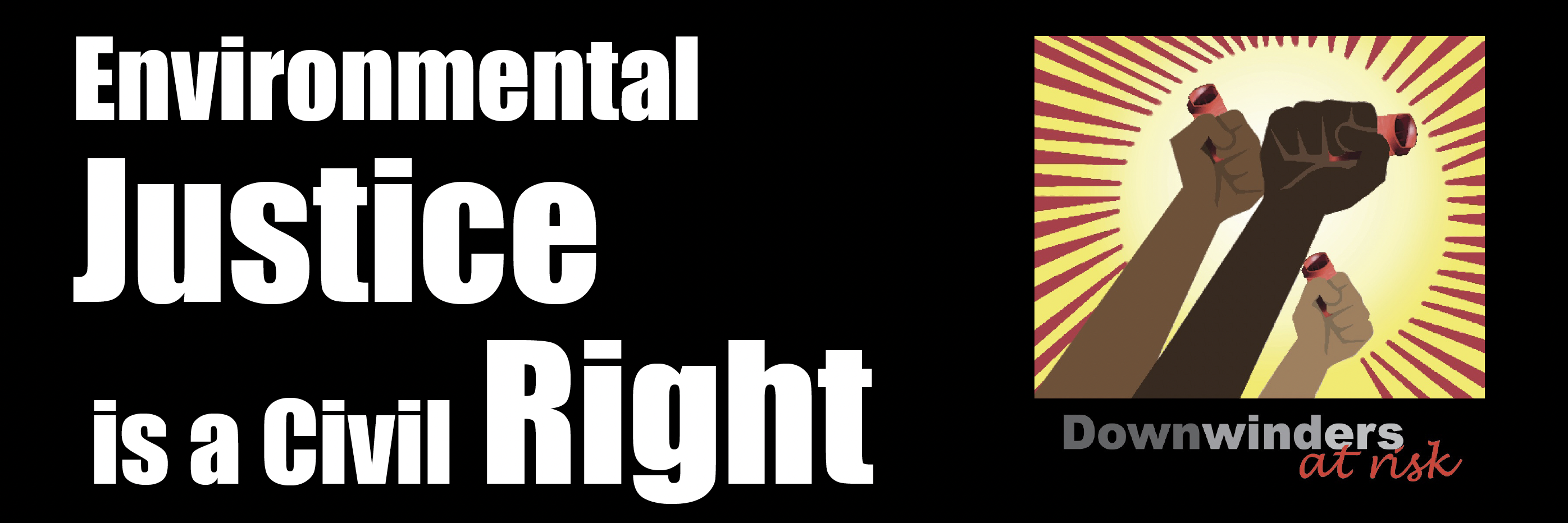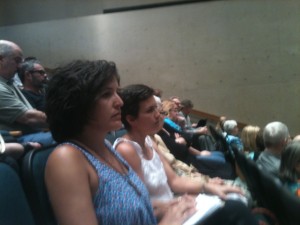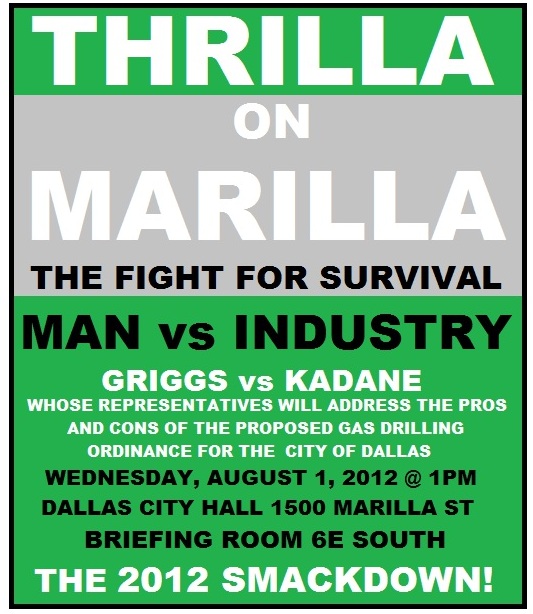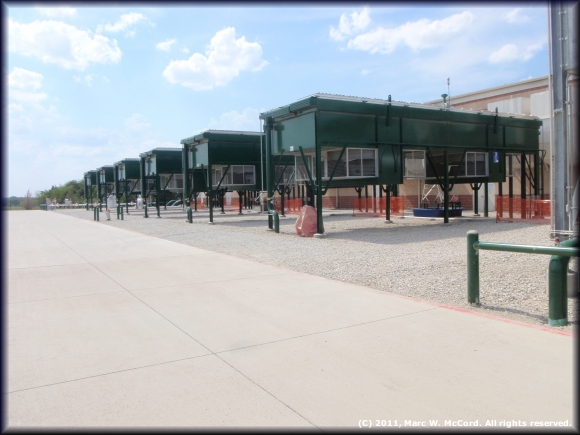Fracking
Possible New Catalyst for Methane Capture in Cars and Gas Field
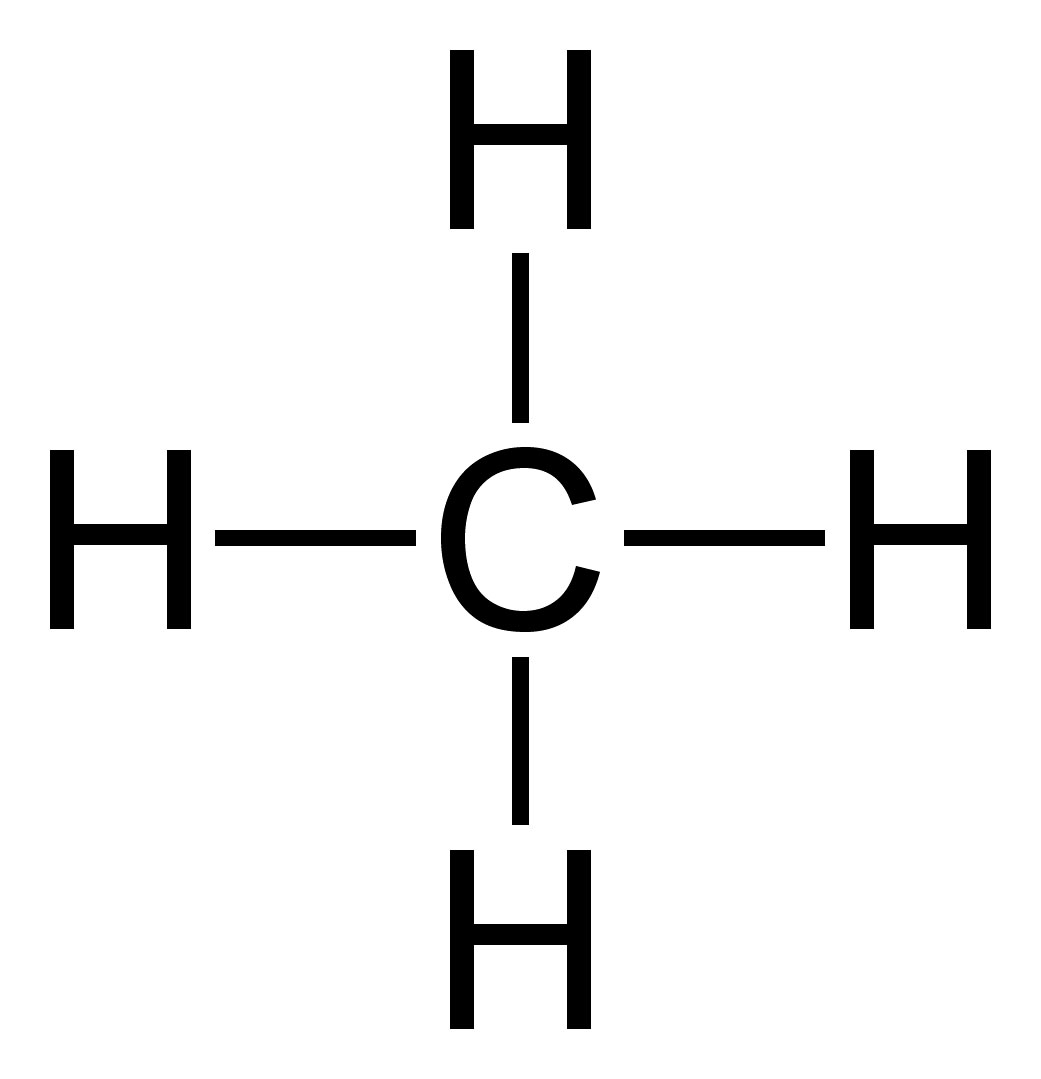 Via Chemical and Engineering News comes word that scientists from the University of Pennsylvania and the University of Trieste in Italy have developed a new low-temperature catalyst material that could remove methane emissions form vehicles as well as many different gas and oil field facilities. It would work the same way your car's catalytic converter works now – you force the emissions through a cylinder web or screen coated with a chemical designed to pick up specific molecules.
Via Chemical and Engineering News comes word that scientists from the University of Pennsylvania and the University of Trieste in Italy have developed a new low-temperature catalyst material that could remove methane emissions form vehicles as well as many different gas and oil field facilities. It would work the same way your car's catalytic converter works now – you force the emissions through a cylinder web or screen coated with a chemical designed to pick up specific molecules.
In the past, this process didn't work with Methane until you reached higher temps than are usually found in a car's engine. The breakthrough being reported solves that problem by allowing the capture of methane to take place at lower temperatures. Still in the testing phase, but we need to be on the lookout for better ways to capture methane pollution, which has been found to be something like 26 times more destructive to climate change per ton as CO2.
"Edman Tsang of Oxford University, an expert on catalysis and clean energy, says: “There is a tremendous need to remove small amounts of methane from the exhausts of gas turbines and internal combustion engines and from flue gases in petrochemical and related industries. The generally low activity of conventional catalysts and their instability at high temperatures” have made it difficult to meet this challenge, whereas the new catalyst makes a first step toward a solution. The approach needs further assessment but provides “a clear direction” for future research, he says."
Thank you, It WAS a Watershed Moment in the Dallas Drilling Fight
 Yesterday's Dallas City Council briefing on a new gas drilling ordinance was supposed to be a showdown between dueling spokespeople for pro and anti-fracking arguments. And it did provide lots of memorable exchanges and statements. But the most dramatic moment of the day came courtesy of the audience itself.
Yesterday's Dallas City Council briefing on a new gas drilling ordinance was supposed to be a showdown between dueling spokespeople for pro and anti-fracking arguments. And it did provide lots of memorable exchanges and statements. But the most dramatic moment of the day came courtesy of the audience itself.
Dallas municipal law attorney Terry Welch was coming to the end of his presentation on why the recommendations from the city's task force should be strengthened: If we're wrong and fracking turns out to be completely safe, then you can always come back and liberalize strict regulations. But you can't undo the damage once drilling takes place with insufficient safeguards. Err on the side of public health and safety.
And with that, 90% of the packed room erupted into at least 60-90 seconds of continued and loud applause. But that wasn't the moment.
Because he had ended early, even after this round of applause, Welch had time left. Mayor Rawlings noted that and said something to the effect that "If you want to keep applauding for 4 more minutes I won't objec…." The last words of that sentence had not even left his mouth before the crowd took him up on his offer, began clapping wildly again and within seconds jumped to its feet with a sustained standing ovation that went on for the longest time. It was one continuous loud and kinetic vote in favor of doing more that was aimed directly at the Mayor and Council. That was the moment.
This was no public hearing, but the public most certainly was heard. It was the first time the Council had seen the depth and breath of support for stronger drilling rules. The pent-up energy from that applause was like a Blue Norther hitting the Council horseshoe straight-on.
Likewise, it was the first time the Council's constituents had seen the depth and breath of the pro-drilling members' belligerence and hopelessly out-of-date attitudes. It produced a lot of head-shaking.
We hope to bring you selected video from the meeting over the next couple of days. Meanwhile, here's a pretty good summary from the live blogging the Morning News was posting (do tell!), as well as a more sedate article for the paper itself.
Some highlights:
– You Care. There were so many of you – in August during work hours – that they had to move the meeting from the smaller briefing room to the Council Chambers, which were quickly filled too. It was a tremendous turnout. Thank you.
– Industry isn't satisfied. It's clear now that industry is trying to rollback the required distances between homes and wells even further than what the city's Task Force recommended after their last-minute collapse in February. A variance of 750 feet is no longer adequate. Now they want 600 feet. That's 400 feet closer than a strip club is allowed to get to a home in the City of Dallas.
– The council most ardent proponents of drilling share Ireland's view that the on-going national debate has been settled in their minds, and there are no serious hazards to fracking in urban areas.
– Mayor Rawling is very much engaged in this process and issue. He was attentive, asked good questions, and kept the lengthy proceedings flowing smoothly but democratically. Whatever else you may think of him or his motives, he's focused and direct on this subject.
– Citizen advocates Scott Griggs, Sandy Greyson, Angela Hunt and Carolyn Davis all asked great questions and provided a counterbalance to the Troglodyte contingent of the Council. You might want to drop them a thank you note.
– "Sulfuric Sheffie" Kadane – In what was the most jaw-dropping exchange of the day, Councilmember Kadane asked Welch if he knew what kind of chemicals would be spilled at a fracking site. Not waiting for an answer, he offered not benzene, or toluene, or diesel fuel, but Sulfuric Acid. Perfectly harmless stuff! We use it to clean our swimming pools! A little Sulfuric Acid wasn't going to hurt anyone.
– Jerry "El Conejo "Allen – Councilman Allen was obsessed with all the "rabbit holes" Welch and other could go down in terms of the hazards of fracking and thought he had all the ammunition he needed from spending a couple of hours going down some of them via Google. These rabbit holes are known to the rest of us as research. Did Welch know that the Trinity River was full of treated sewage right now?! Did he know how many regulatory agencies oversaw fracking? Did he know that thousands of people die every year from exposure to chemicals in the home? Wasn't fracking only dangerous because people were talking about it? Above all else, he kept reminding everyone that the gas operators had already paid the city 34.8 million for lease rights and not only do they deserve something in return but that's a lot of money!
Angela "Law and Order" Hunt – The most revealing exchange all day was Hunt's cross examination of hostile witness Ed Ireland, the gas PR hack Kadane had chosen to give the industry arguments, over full disclosure of all chemicals being used in fracking. She asked Ireland if he had any problem with Dallas writing an ordinance that would demand the listing of every single chemical being used on site. Not at all, Ireland said. Of course, he added, the operators themselves don't always have the last say. They hire contractors like Haliburton to come in and actually do the fracking and THEY might have a problem disclosing their fracking fluid recipes. Three times Hunt posed the same question, never letting Ireland escape a conclusive, definitive answer. Do you support full disclosure? And Ireland gave three slippery answers that finally pulled the curtain away from the industry's premeditated deception.
We're gaining momentum. By the end of he day, there was such a stark contrast between the advocates and arguments for more protections versus the Hollywood-scripted arguments of the other side, that you could almost hear the collective council pivoting to our side, despite no vote being taken. We can't afford to be over confident, but if we keep the pressure on, we can win this fight.
Next stop – We need at least one, if not two evening public hearings on the ordinance. As you contact your city council reps, please be sure to include this request.
Now Frackers Whine About Process? Be at Dallas City Hall at 1pm To Make Them Really Mad
 According to a chain of e-mails published by the Dallas Observer, some industry supporters who were members of the Dallas Gas Drilling Task Force – the very same members who helped engineer the rollback of protections at the very last meeting without any opportunity for public comment – are all in a tizzy over council member Scott Griggs picking Task Force member Terry Welch to give today's presentation of the "Minority Report" of the Task Force recommendations beginning at 1 pm. They're claiming it's just not fair to pick someone who's actually knowledgeable about how and why the rollbacks occurred. Yep, that's some dirty dealing all right.
According to a chain of e-mails published by the Dallas Observer, some industry supporters who were members of the Dallas Gas Drilling Task Force – the very same members who helped engineer the rollback of protections at the very last meeting without any opportunity for public comment – are all in a tizzy over council member Scott Griggs picking Task Force member Terry Welch to give today's presentation of the "Minority Report" of the Task Force recommendations beginning at 1 pm. They're claiming it's just not fair to pick someone who's actually knowledgeable about how and why the rollbacks occurred. Yep, that's some dirty dealing all right.
It's really rich for those who hijacked the Task Force process to now complain about who gets to give the PowerPoint for the other side.
Who better to be able to talk about what the Task Force did and why than someone who was there? Well, the industry supporters on the Council picked good ol' Ed Ireland to give the rebuttal to Welch. Ireland showed up at exactly one meeting to testify on behalf of his clients. He has no idea what the Task Force debated prior to its votes. Maybe he doesn't look like such an inspired choice now.
Whatever the reason, this digital hissy fit is an indication the gas industry is desperate. Perhaps they're worried that their Task Force coup d'etat won't succeed. But you know what would make it a really horrible day for the fracking folks in Dallas? If all of you showed up at 1 pm at City Hall to once again vote with your bodies for stronger protections to be included in a new gas drilling ordinance, including off-sets. Come and watch what may be a watershed moment in this now two-year old fight.
Groups Sue Over Fracking Causing Rural Utah Smog Problem
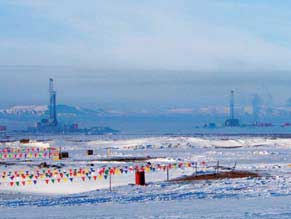 Last week five groups, including Utah Physicians for a Healthy Environment, EarthJustice, and the Southern Utah Wilderness Alliance sued the EPA for not classifying the Uintah Basin as a "non-attainment area" for the new federal ozone standard despite having plenty of evidence that the gas mining region is routinely experiencing some of the worst smog in the country.
Last week five groups, including Utah Physicians for a Healthy Environment, EarthJustice, and the Southern Utah Wilderness Alliance sued the EPA for not classifying the Uintah Basin as a "non-attainment area" for the new federal ozone standard despite having plenty of evidence that the gas mining region is routinely experiencing some of the worst smog in the country.
"It was once considered strictly a summertime problem in big cities. But winter pollution readings from the oil and gas fields of Wyoming and eastern Utah in the past seven years have shown the pollutants that create ozone— nitrogen oxides and volatile organic compounds — can also cause problems in snowy, rural areas.
Monitoring data in the Uintah Basin collected between 2009 and 2011 shows violations of federal health limits on ground-level ozone, which are set at 75 parts per billion. In 2010 and 2011, ozone levels rose as high as 121 parts per billion and 139 parts per billion, respectively."
To most of us this would mean the area is indeed due a non-attainment designation and should be required to draw up a plan to bring smog levels down. But to EPA, this only means the area is "unclassifiable," and it can put off that planning. That's why the groups are suing. And that's why it doesn't pay to think the EPA is taking care of everything.
But think about how this situation tests the claims of the gas industry operators.
In a previously pristine environment, without any cars or other kinds of heavy industry, they've now created smog on par with Los Angeles and Houston in the middle of extremely rural Utah…in the wintertime! They say they don't need new regulations; that they can voluntarily apply pollution controls. But in Utah, they either haven't done so in sufficient numbers, or those controls are clearly inadequate. Something more is needed than just voluntary controls.
Something like off-sets that require you to reduce as much air pollution as you spew.
We Need Your Help on Wednesday
 Dallas is writing a new gas drilling ordinance. As part of this new set of rules, we have a chance to win the nation's first "off-sets" program for air pollution from gas drilling and processing.
Dallas is writing a new gas drilling ordinance. As part of this new set of rules, we have a chance to win the nation's first "off-sets" program for air pollution from gas drilling and processing.
Off-sets would require gas operators to pay for decreasing as much greenhouse gas air pollution as they're estimated to emit every year. If a company's annual air pollution emissions total 5 tons a year, it would have to fund projects that would reduce air pollution by 5 tons a year.
Every other major industrial source of air pollution in the DFW area is already subject to off-sets because of anti-smog regulations. Even though they can emit more air pollution than many of these industrial sources, a loophole allows gas operators to escape this requirement.
Greenhouse gases include smog-forming Nitrogen Oxide, CO2, and methane. Applying this program means Dallas would be the first local government in the country to require the gas industry off-sets. This would set a precedent and could be copied by other local governments in North Texas, just like Downwinders' Green Cement policies. And like those Green Cement policies, they could lead to significant air pollution reductions all over the region.
Off-sets help balance the costs of drilling by better reflecting its true impact. They act as an incentive to reduce pollution at the source. Together with larger buffer zones protecting homes and schools, and bans on drilling in parks and floodplains, off-sets can be part of a much tougher Dallas ordinance.
If off-sets are not required, new increases in gas industry emissions will continue to cancel out the kind of progress we've all worked so hard to achieve. As drilling has marched east, air monitors officially violating the old 85 parts per billion ozone standard have moved east as well. This year, we've already seen a monitor at I-35 and Mockingbird in inner city Dallas violate that standard – something it had not done since 2005.
We're now in the final stages of decision-making about the content of the Dallas ordinance. Beginning at 1 pm Wednesday at Dallas City Hall in Room 6ES, there's going to be a showdown of industry vs citizens.
Notorious gas industry PR spinmeister Ed Ireland will be speaking for 15 minutes about why Dallas needs to keep regulations loose. Attorney and Dallas gas drilling task force member Terry Welch will get 15 minutes to explain why the city needs to get tougher in its rules for drilling. Then the City Council will get to ask questions. No final decision for now, but the tone that's set at this "briefing session" will be critical.
Even if you don't live in Dallas, you have a stake in this decision. The pollution spewed by the gas industry in Dallas can become smog over Arlington, Ft. Worth, Denton, or Weatherford.
To be sure the Council members understand how important this issue is to Dallas' future and your present, we need you there at City Hall on Wednesday. Nothing says "concern" better than lots of people showing up to watch what happens. Likewise, empty seats are taken to mean there isn't much interest. It's during a workday, but if you can come, or send someone in your place, the effort will be worth it.
Videos and Pics of the DC Frack Attack Rally
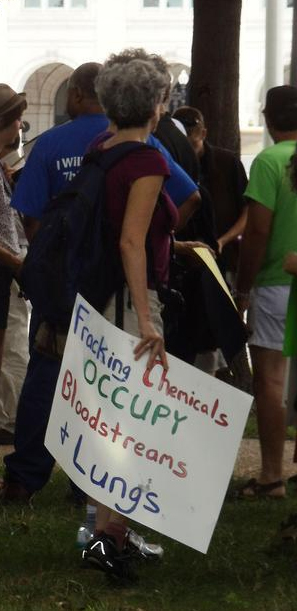 Via the Digital Journal, and Flickr here's a good sampling to give you a taste if you weren't there.
Via the Digital Journal, and Flickr here's a good sampling to give you a taste if you weren't there.
Think Nationally. Act Rationally. Stop the Frack Attack in Dallas
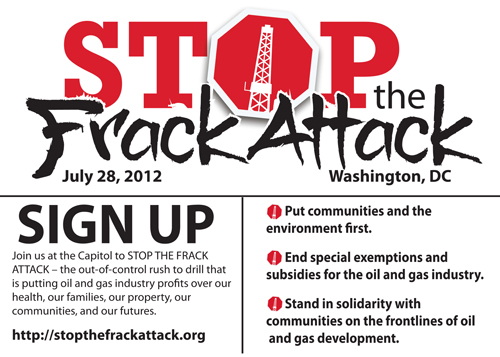 We want to extend a big ol' thank you to all those Barnett Shale residents who are in our nation's capital right now getting ready to attend the largest national rally on fracking ever held in the US.
We want to extend a big ol' thank you to all those Barnett Shale residents who are in our nation's capital right now getting ready to attend the largest national rally on fracking ever held in the US.
Former DISH Mayor Calvin Tillman, Earthworks' Sharon Wilson, former Decatur resident and gas victim Tim Ruggiero, are all among those up in Washington, giving interviews and raising constructive hell with the Texas Congressional delegation. Along with Don Young and CANDO, Gary Hogan and the folks at the North Central Texas Communities Alliance, and Susan Read in Grand Prairie, these are the most stalwart heroes of our local Shale fight.
Going on seven years now, they've been taking on the Oil and Gas industry in Texas (spend a moment thinking about what that means) on behalf of not only their own neighborhoods, but ours as well. And they started without all the evidence we have now about the hazards of fracking – known and unknown. All they had was their common sense and intuition.
And it was very lonely. For so long it was only the Barnett Shale that was in play. Only the middle of the country, in places where the nation's press wasn't headquartered, where celebs didn't have their summer homes, where, it seemed, nobody that could help them, cared about them.
Traditional environmental groups who they thought might side with them were instead being funded by their opponents because "natural gas was so much cleaner than coal." Non-traditional ones, like Downwinders we're sorry to say, were just not paying enough attention or had their own full agendas. So this first generation of fracking opponents had to start from scratch, with none of the resources, expertise, or support that just about any other environmental cause could expect to receive.
But they kept at it. And they built a huge library of real world knowledge about fracking. Not the theoretical PR clams, but what actually happens to people and land when the rigs show up. Their knowledge was so essential that a budding film maker named Josh Fox knew he had to make the Barnett Shale one of the stops to talk with them for his new film "Gasland." Their knowledge was going national just like the drilling.
Because as usually happens, greed got the better of an industry. The gas companies couldn't stop with the Barnett, or other rural western plays. They had to go east, to Pennsylvania, to New York, within hours of Manhattan. They began to imperial the summer homes, or water sources, or views, or health of very rich and powerful people who have access to more resources than your average angry DFW resident. Fracking got more media attention. It got more research attention in academia. It's becoming a part of popular culture. David Letterman is now ranting about fracking.
And tomorrow's rally in DC makes it official – fracking is now a national environmental controversy that's forcing citizens to build a national environmental movement. At the center of that movement, and somewhere in the center of that crowd tomorrow, stands those folks from the Barnett Shale who are finally seeing their cause get the kind of attention it deserves. It will be a banner day. Better late than never.
How can you help that movement if you're not in DC this week? By exploiting every opportunity to use what we now know about Fracking thanks to those early activists.
The largest city in the Barnett Shale is in the final stretch of writing a new gas drilling ordinance. This Wednesday at 1 pm on the 6th floor of Dallas City Hall, the City Council will be receiving its second briefing on the hazards of fracking. We need you there to show the Council you're interested in seeing a strong and protective ordinance. In Dallas, we have a chance to make progress in making the industry begin to pay for its own pollution, to set precedents that will be important. We can win. We can make things better. We can honor those whose work has given us a multitude of evidence of harm by using it to grab this Dallas ordinance by the horns and make the most out of it. Want to support the national anti-fracking movement? Think Nationally. Act Rationally in Dallas.
One Week From Today: Gas Drilling Showdown at Dallas City Hall
What To Expect When You’re Expecting Gas Drilling
If you're a Dallas resident and you want to find out more about the kinds of new facilities that might be located near you if gas drilling is allowed in your city per the new ordinance the Council is debating on August 1st, here's a item of interest from West Virginia, where operators are already fracking.
"Sulfur dioxide, carbon monoxide and formaldehyde are some of the chemicals Chesapeake Energy is likely to pump into the air in Ohio County from its numerous drilling sites, company information states.
Earlier this year, Chesapeake officials confirmed plans to build local compressor stations that may release these and other chemicals into the atmosphere. Now, the company is identifying "potential to emit" levels for several potentially hazardous materials from its well drilling sites.
The amounts of the particulates that may be released at the four sites slightly vary. The carbon monoxide projections, for example, range from 40 tons per year to 61.5 tons per year to be released from a single site.
In addition to the pollution from the well sites, Chesapeake also will release emissions from its local compressor stations. Chesapeake, in a legal advertisement earlier this year, confirmed the "potential to discharge" the following amounts of these materials on an annual basis from the operations at the compressor stations: carbon dioxide – 93,800 tons; nitrogen oxides – 82.96 tons; carbon monoxide – 16.87 tons; methane – 86.64; carbon dioxide equivalent – 95,667 tons; benzene – 0.33 tons; and formaldehyde – 3.22 tons."
Formaldehyde and Benzene are both carcinogens. Carbon Dioxide is the primary greenhouse gas pollutant, and methane is right behind. Nitrogen Oxide is the primary component of smog in DFW. All this – 93,000 tons a year of air pollution – from just one gas compressor. Where in Dallas would you propose to put a facility that spews that much air pollution? And how would you keep it from adding to the chronic air quality problem the City already has? And then what about the fact that the operators might not need just one, but three, or five, or ten of these compressors in Dallas? It's not uncommon to build complexes that house as many as a dozen or more locomotive-size compressors in the Barnett Shale, which includes at least the western half of Dallas.
When you allow drilling, you're allowing everything else that follows drilling, including compressors and their pollution, storage tanks that leak copious amounts of the same kind of pollution, pipelines that can use eminent domain to run through your front yard, and a host of other hazards, some of which we know about, some of which we no doubt have not yet discovered. Gas mining is not conducive to neighborhoods or attracting new, non-polluting development. If Dallas City Hall doesn't know this now, it most certainly will learn it later.
Low Birth Weight Pregnancies 25% More Likely Within 1.5 miles of Fracking
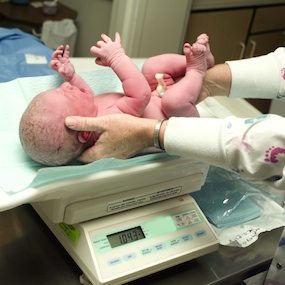 A mother's exposure to fracking increases the chance a a low weight birth by 25%, according to a new study by Elaine Hill, a doctoral candidate at Cornell University. Hill's research also found a 17% increase in "small for gestational age" births and reduced health scores among newborns whose moms lived close to fracking sites.
A mother's exposure to fracking increases the chance a a low weight birth by 25%, according to a new study by Elaine Hill, a doctoral candidate at Cornell University. Hill's research also found a 17% increase in "small for gestational age" births and reduced health scores among newborns whose moms lived close to fracking sites.
“Unconventional Natural Gas Development and Infant Health: Evidence from Pennsylvania” is the working title of the study, which has not yet been peer-reviewed or journal-published. Hill used data from 2010 and focused on those living up to 1.5 miles from gas development sites. Pennsylvania increased its unconventional natural gas wells from 20 in 2007 to 4,272 by the end of 2010.
Hill publicized her findings at a public hearing in New York state, which is considering new regulations for fracking. She decided to come forward now, rather than wait for up to two years for the review process to accredit her research because she believes her study has implications policy makers need to incorporate into those regulations.
“My study is robust across multiple specifications and it indicates that our future generation may be seriously harmed. I couldn’t possibly value my career over their well-being,” Hill said by email last Thursday.
We already have a Colorado School of Public health study released in March that shows a 66% higher chance of getting cancer if you live within a half mile of a fracking site. Hill's study is the first to track health effects up to a mile and a half away.
These reports are in addition to the hazard of earthquakes now officially linked to fracking waste injection wells by the US Geological Society, and the risk of getting silicosis from breathing in illegal levels of sand particles noted by industrial hygienists – both from earlier this year. All of this is new research that didn't exist before 2012. What other hazards are we ignorant of this year?
Just another reason why you should be at Dallas City Hall at 9 am on Wednesday, August 1st for the Thrilla on Marilla.
